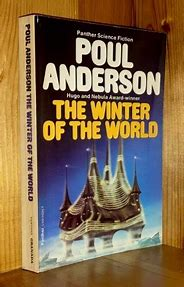The Winter Of The World, XVIII.
(From early Tuesday until late on Thursday or even Friday, we will be out of town and I will be off this blog. A welcome break for everyone.)
Sidir leads his men across tundra, swamp and morraine beside the Ice into Roong in a cleft of the glacier. The Rogaviki mine the Roong "towers" (skyscrapers), salvaging from the top first, in the summer and transport steel beams, copper wire, aluminium sheet and other metals across tundra frozen hard in winter. Sidir climbs a tower and wonders where Donya is so the following chapter opens with her.
Roong is the perfect setting for "giant spiders" (not literally) or other fabulous monsters but the Imperials enter unopposed. Sidir is confident that the Rogaviki will not lurk in ambush and he is right. Roong is common property, not kith territory, therefore not defended fanatically and the Northfolk will not be there while their trade routes are cut off. The Rogaviki have been effective at driving the wild herds beyond the reach of the invaders but Sidir had been careful not to depend on hunting.
The glaciers went round instead of across Roong because the ancients had struggled to preserve it by digging channels and erecting dams. Windows are empty. Gaps in walls are open to weather and rats. Roofs have fallen through multiple floors. Rubbish and soil have buried entrances. Lichen has ascended walls. Hawks and owls inhabit the highest floors.
Sic transit gloria mundi.

8 comments:
See 'Kalgar' in "Orion Shall Rise".
Though with the climate no colder than at present Calgary has a modest population living near the abandoned skyscrapers.
The rainshadow (or snowshadow) of the Rocky Mountains might keep the location of Calgary glacier free for some time in a future glacial period. It is known that there were times when there was a gap between the Cordilleran and Laurentian ice sheets, during the Wisconsin glacial period. However, the two ice sheets did converge at times, so the debris Calgary's buildings would probably end up in the terminal moraine somewhere to the south.
I would expect cities like St. Louis to be mined for metal also, but probably mined out while the more hostile climate of Roong has kept it relatively unused.
Kaor, Paul and Jim!
Enjoy your holiday! At least I will have time to catch up with combox commenting. (Smiles)
Again, we see signs of how dangerously addictive Rogaviki "witches" can be for humans. Sidir's longing for Donya was warping his objectivity and ability to plan rationally.
Jim: THE WINTER OF THE WORLD also shows us how Anderson moved away from the mistake he made in the Maurai short stories, where he assumed the War of Judgment would make metals prohibitively costly and rare. Stirling explained that would not be the case: there would still be mines the survivors could use for obtaining metals. Also, ruined cities would also be "mined" for metals. To say nothing of all the metals in abandoned cars, washing machines, refrigerators, stoves, or toasters!
Yes, cities south of Chicago, like St. Louis, would get mined out more quickly.
Ad astra! Sean
Note that prior to the Industrial Revolution, people mined metal (iron, particularly) from -small- deposits.
There are -lots- of those small deposits. Fuel -- trees for charcoal -- was the limiting factor.
With the Industrial Revolution they moved to mining -big- deposits, often located far away, smelting them with coke from coal.
The reason was not that the small deposits were exhausted; the reason was that they were uneconomic for large ironworks, because bulking the many small deposits would cost too much in transport.
It paid to find very large deposits -- Mesabi, Kiruna, Magnitogorsk -- and transport the ore from a single source.
Hence if industrial civilization were destroyed, people could go right back to mining small, widely-scattered deposits for their more modest needs.
And those deposits would last, at pre-1750 levels of use, for tens of thousands or hundreds of thousands of years.
Kaor, Mr. Stirling!
I agree, and I did have these facts in mind when I wrote my prior comments above.
What puzzles me, really, is why Anderson wrote the Maurai short stories the way he did. Surely he must have known of how numerous those smaller deposits of iron ore were and how they would be used by any post-industrial collapse renascent civilizations?
Ad astra! Sean
'aluminum sheet'
That is an interesting note.
A society without industrial scale electricity would not be able to extract aluminum from bauxite economically. Aluminum would be a precious metal the way it was before the Hall-Heroult process was developed.
Kaor, Jim!
I agree, aluminum would become a highly coveted precious metal.
Ad astra! Sean
Sean: I think Poul just accepted that the smaller deposits -were- worked out.
If you look at historical exhibitions based on those smelters, the captions usually mention that the ore deposit was worked out. And it often was... but there was always another one.
Of course, some -weren't-. The giant Erzberg mine in Styria (Austria) has yielded hundreds of millions of tons of 50% iron ore, and still has hundreds of millions left.
It was also the site of iron-smelting from Celtic through Roman through medieval times. The limiting factor there would have been wood for charcoal(*)!
Even over 1,500 years, the amount of ore mined for -those- smelters would be about a month's worth of modern open-pit mining.
(*) Forests near iron-smelting sites in Europe were usually carefully managed by pollarding to yield a steady stream of charcoal. In colonial America, they often just cut everything down and moved on.
Kaor, Mr. Stirling!
That makes sense, in the 1950's Anderson did not realize how numerous were those smaller deposits of iron ore. To say nothing of possibly not knowing about the Erzberg mine.
Ad astra! Sean
Post a Comment